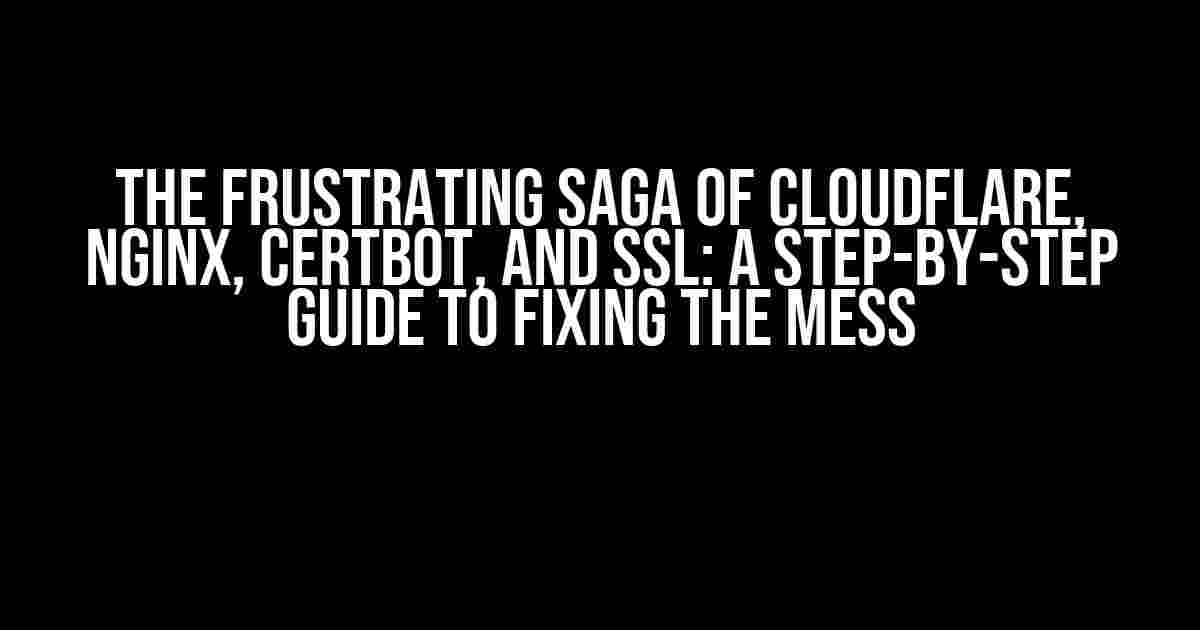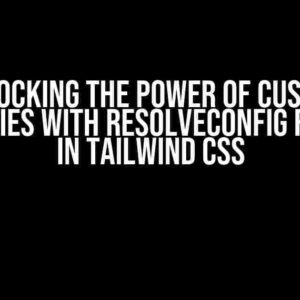Are you tired of dealing with the headaches caused by Cloudflare, Nginx, Certbot, and SSL not playing nicely together? You’re not alone! Many webmasters have fallen victim to the frustrating combination of these popular tools. But fear not, dear reader, for we’re about to embark on a journey to tame the beast and get your SSL certificates working seamlessly.
The Problem: Cloudflare’s DNS Proxied Subdomains
The root of the issue lies in Cloudflare’s DNS proxied subdomains. This feature, meant to improve security and performance, can sometimes cause Certbot to issue SSL certificates that aren’t compatible with Nginx. The result? Your website is left with a broken SSL connection, and your visitors are greeted with an ominous “Not Secure” warning.
Understanding Certbot’s Role in the Chaos
Certbot, the automated SSL certificate issuer, is usually a wonderful tool. However, when paired with Cloudflare’s DNS proxied subdomains, it can create a mess. Certbot relies on the DNS-01 challenge to verify domain ownership, but Cloudflare’s proxied subdomains can interfere with this process. The outcome? Certbot issues an SSL certificate that’s not compatible with Nginx, leaving your website exposed.
The Solution: A Step-by-Step Fix
Fear not, dear reader, for we’ve got a comprehensive guide to help you overcome this challenge. Follow these steps carefully, and you’ll be enjoying a secure, SSL-encrypted connection in no time.
Step 1: Disable Cloudflare’s DNS Proxied Subdomains
Log in to your Cloudflare account and navigate to the DNS tab. Find the subdomain that’s causing the issue and toggle the “Proxied” switch to the “DNS only” position. This will allow Certbot to complete the DNS-01 challenge successfully.
Step 2: Update Your Nginx Configuration
Open your Nginx configuration file (usually located at `/etc/nginx/sites-available/default`) and add the following lines:
server {
listen 443 ssl;
server_name example.com;
ssl_certificate /etc/letsencrypt/live/example.com/fullchain.pem;
ssl_certificate_key /etc/letsencrypt/live/example.com/privkey.pem;
...
}
Create a new file in the `/etc/nginx/conf.d/` directory, name it `ssl.conf`, and add the following contents:
server {
listen 443 ssl;
server_name example.com;
ssl_stapling on;
ssl_stapling_verify on;
ssl_trusted_certificate /etc/letsencrypt/live/example.com/chain.pem;
...
}
Step 3: Renew SSL Certificates with Certbot
Run the following command to renew your SSL certificates with Certbot:
sudo certbot certonly --nginx --agree-tos --email [email protected] --non-interactive --expand --domains -d example.com,www.example.com
Make sure to replace `example.com` with your actual domain name.
Step 4: Update Your Cloudflare SSL/TLS Settings
Log in to your Cloudflare account and navigate to the SSL/TLS tab. Ensure that the “SSL/TLS encryption mode” is set to “Full” or “Full (Strict)” and that the “Minimum TLS version” is set to “TLS 1.2” or higher.
Step 5: Verify Your SSL Certificate
Use an online tool, such as SSL Labs or Why No Padlock, to verify that your SSL certificate is correctly installed and configured.
Common Errors and Troubleshooting
Encountered an issue during the process? Fear not, dear reader, for we’ve got you covered!
Error: Certbot Fails to Renew SSL Certificates
If Certbot fails to renew your SSL certificates, try the following:
- Check your Cloudflare DNS settings to ensure that the subdomain is not proxied.
- Verify that your Nginx configuration is correct and that the `ssl_certificate` and `ssl_certificate_key` paths are accurate.
- Run `sudo certbot renew –nginx` to attempt to renew the SSL certificates again.
Error: Nginx Fails to Load the SSL Certificate
If Nginx fails to load the SSL certificate, try the following:
- Check the permissions on the `/etc/letsencrypt/live/example.com/` directory and ensure that Nginx has read access.
- Verify that the `ssl_certificate` and `ssl_certificate_key` paths in your Nginx configuration are correct.
- Restart Nginx using `sudo service nginx restart` or `sudo systemctl restart nginx`.
Conclusion
Taming the beast that is Cloudflare, Nginx, Certbot, and SSL can be a daunting task. However, by following these steps and troubleshooting common errors, you’ll be well on your way to enjoying a secure, SSL-encrypted connection. Remember to stay vigilant and regularly verify your SSL certificate to ensure that it remains valid and correctly configured.
| Tool | Purpose |
|---|---|
| Cloudflare | Content delivery network (CDN) and security platform |
| Nginx | Web server and reverse proxy |
| Certbot | Automated SSL certificate issuer |
| SSL/TLS | Encryption protocol for secure data transfer |
Now that you’ve successfully navigated the treacherous waters of Cloudflare, Nginx, Certbot, and SSL, take a deep breath and pat yourself on the back. You’ve earned it!
Final Check
Before we bid adieu, let’s perform a final check to ensure that everything is in working order:
- Verify that your SSL certificate is correctly installed and configured.
- Check that your website is accessible via HTTPS.
- Confirm that Cloudflare’s DNS proxied subdomains are disabled or set to “DNS only” mode.
- Test your website’s SSL encryption using online tools like SSL Labs or Why No Padlock.
By following these steps and staying vigilant, you’ll be enjoying a secure, SSL-encrypted connection in no time. Happy troubleshooting, and may the odds be ever in your favor!
Frequently Asked Questions
Got issues with Cloudflare messing up your Nginx Certbot SSL? Don’t worry, we’ve got you covered! Here are some frequently asked questions to help you troubleshoot and resolve the problem.
Why is Cloudflare overriding my Nginx SSL configuration?
Cloudflare’s Universal SSL feature can sometimes override your Nginx SSL configuration, causing issues with your Certbot setup. To avoid this, make sure to disable Universal SSL in your Cloudflare dashboard or configure your Nginx settings to use the correct SSL certificates.
How do I configure Nginx to work with Cloudflare’s SSL certificates?
To configure Nginx to work with Cloudflare’s SSL certificates, you’ll need to update your Nginx configuration file to point to the correct SSL certificates. You can do this by updating your server block to include the correct SSL certificate paths and enabling SSL termination.
Why is Certbot not renewing my SSL certificates when using Cloudflare?
Certbot may not renew your SSL certificates when using Cloudflare if the DNS validation is not properly configured. Make sure to update your Certbot configuration to use the correct DNS validation method and ensure that Cloudflare is configured to allow DNS validation.
Can I use Cloudflare’s SSL certificates with my existing Certbot setup?
Yes, you can use Cloudflare’s SSL certificates with your existing Certbot setup. However, you’ll need to update your Certbot configuration to point to the correct SSL certificate paths and ensure that Cloudflare is configured to allow SSL termination.
How do I troubleshoot SSL certificate issues with Cloudflare and Nginx?
To troubleshoot SSL certificate issues with Cloudflare and Nginx, check your Nginx error logs for any SSL-related errors, verify that your Cloudflare configuration is correct, and test your SSL certificates using tools like OpenSSL or SSL Labs.




